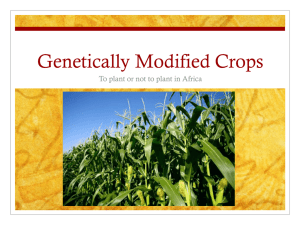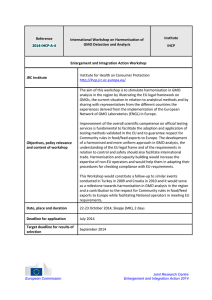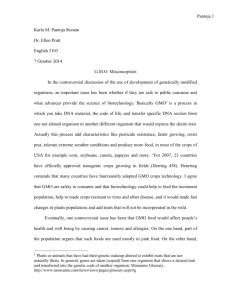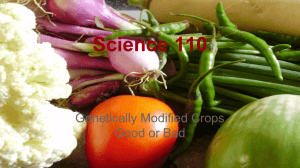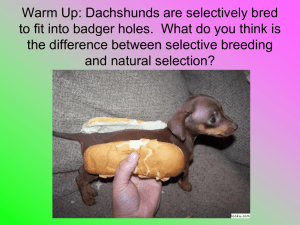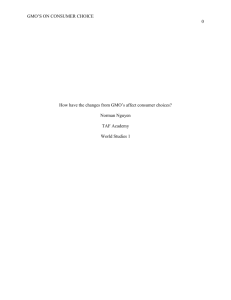Maria LUSSER
advertisement
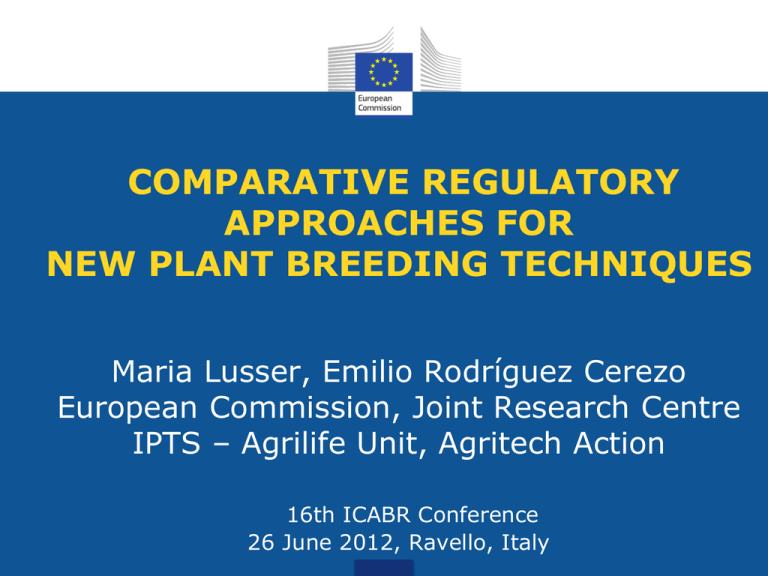
COMPARATIVE REGULATORY APPROACHES FOR NEW PLANT BREEDING TECHNIQUES Maria Lusser, Emilio Rodríguez Cerezo European Commission, Joint Research Centre IPTS – Agrilife Unit, Agritech Action 16th ICABR Conference 26 June 2012, Ravello, Italy New plant breeding techniques (NPBTs) • Breeding techniques which deploy biotechnology • Developed during the last 10 (20) years • Fall product derived through these techniques under the GMO legislation? NPBTs discussed in the EU 1. ZINC FINGER NUCLEASE TECHNOLOGY 2. OLIGONUCLEOTIDE DIRECTED MUTAGENESIS (ODM) 3. CISGENESIS/INTRAGENESIS 4. RNA-DEPENDENT DNA METHYLATION (RdDM) 5. GRAFTING ON GM ROOTSTOCK 6. AGRO-INFILTRATION 7. REVERSE BREEDING JRC Studies on NPBTs JRC STUDY (2011, published 2012) Comparative regulatory approaches for new plant breeding techniques Workshop in September 2011 Represented countries: Argentina, Australia, Canada, European Union, Japan and South Africa Regulatory framework for biotechnology derived crops Regulatory approaches for NPBTs Approaches and decisions for specific groups of NPBTs Complementary information on the USA Publications: Pew Initiative on Food and Biotechnology Guide to U.S. Regulation of Genetically Modified Food and Agricultural Biotechnology Products http://www.pewtrusts.org/uploadedFiles/wwwpewtrustsorg/ Reports/Food_and_Biotechnology/hhs_biotech_0901.pdf Tiptoeing around transgenics Emily Waltz, Nature Biotechnology 30, 215-217 (2012) • REGULATORY FRAMEWORK FOR BIOTECHNNOLOGY DERIVED CROPS EUROPEAN UNION Regulatory system for GM crops since 1990 Amended in 2001 Expanded to food and feed in 2003 EUROPEAN UNION GMO definition: • Directive 2001/18/EC, Article 2 (2) • ‘Genetically modified organism (GMO)’ means an organism, with the exception of human beings, in which the genetic material has been altered in a way that does not occur naturally by mating and/or natural recombination. Directive 2001/18/EC ANNEX 1 A, PART 1 ANNEX 1 A, PART 2 ANNEX 1 B Techniques which are considered to result in genetic modification such as recombinant nucleic acid techniques, micro- and macroinjection and cell fusion Techniques which are NOT considered to result in genetic modification such as in vitro fertilization, natural processes such as: conjugation, transduction, transformation and polyploidy induction Techniques of genetic modification yielding organisms to be excluded from the Directive such as mutagenesis and cell fusion TRANSGENESIS RISK ASSESSMENT MUTAGENESIS ARGENTINA, AUSTRALIA, JAPAN and SOUTH AFRICA Specific regulatory systems for GMOs Authorisation based on risk assessment required before use as food, feed, cultivation, import, etc. GMO Definition in national law In Australia and South Africa: Negative lists CANADA Products derived through biotechnology are to be treated as any other novel product Regulation is triggered by the novel trait of the product and not by the process by which the trait is introduced Assessment of plants with novel traits (PNTs) is based on science and decided case by case UNITED STATES OF AMERICA USDA regulates under the Plant Protection Act the environmental release of certain genetically engineered organisms, which are, or are believed to be, plant pests Permit or notification required for carrying out field trials After field trials, petition for non-regulated status may be submitted Accompanied by studies, data incl. results from field trials which demonstrate that there is no significant plant pest risk • REGULATORY APPROACHES FOR NPBTs EUROPEAN UNION (1) • “WORKING GROUP ON NEW TECHNIQUES” (NTWG) - experts from Member States managed by DG SANCO • Evaluated whether NPBTs constitute techniques of genetic modification and • Whether the resulting organisms falls under EU GMO legislation • Evaluation started in 2008 • Report was finalised in January 2012 (not public) EUROPEAN UNION (2) • EUROPEAN FOOD SAFETY AUTHORITY (EFSA) Mandate of DG SANCO in 2011 to address the safety aspects of NPBTs Scientific opinion addressing the safety assessment of plants developed through cisgenesis and intragenesis (2012) Currently evaluation of ZFN and meganuclease technology EUROPEAN UNION (3) JOINT RESEARCH CENTRE (JRC) 2010 Study on “New plant breeding techniques: state-of-the-art and prospects for commercial development” 2011 Study on “Comparative regulatory approaches for new plant breeding techniques” ARGENTINA • A group of experts started to study the issue of NPBTs • Discuss technique-by-technique • Preliminary conclusions reached for most of the techniques AUSTRALIA • Developers are encouraged to contact the regulator with specific cases of crops derived by NPBTs where the regulatory status is not clear • So far has not publicly given general guidance • Intended to continue with this approach until more experience with NPBTs is aquired CANADA • Crops with novel traits have to pass assessment and authorisation process, independent of the technology used • Example: Sulfonylurea tolerant canola produced by ODM Triggered legislation because of herbicide tolerance (issues to be taken into account: management of volunteers or emergence of herbicide resistant weeds) JAPAN • Officials from six ministries meet regularly for consulting and coordinating activities under the GMO legislation • Collect information to NPBT crops and consider classification on a case-by-case basis • No final conclusions have been reached so far SOUTH AFRICA • Experience with NPBTs limited to some research activities • Initial considerations have started following the invitation to JRC workshop UNITED STATES OF AMERICA • USDA has been contacted by companies which are developing crops by NPBT (before field trials) • Letters from USDA directed to companies were send stating that crops derived by certain techniques do not fall under USDA’s oversight (decision for techniqe or specific event) • Some of these decisions are public (USDA website) • APPROACHES AND DECISIONS FOR SPECIFIC GROUPS OF NPBTs GROUPS DISCUSSED • GROUP 1: TARGETED MUTAGENESIS ZFN, ODM, Meganuclease technique • GROUP 2: CISGENESIS AND INTRAGENESIS • GROUP 3: TRANSGENIC CONSTRUCT DRIVEN BREEDING RdDM, Reverse Breeding • GROUP 4: OTHERS Grafting on GM rootstock, Agro-infiltration GROUP 1: TARGETED MUTAGENESIS Zinc Finger Nuclease technology (ZFN 1-3) Oligonucleotide directed Mutagenesis (ODM) Meganuclease technique REGULATORY DISCUSSIONS AND DECISIONS ZFN-1 and meganuclease techniques wherby no template sequences are introduced will be most likely classified as non GM in most of the countries participating in the workshop ZFN-3 or meganuclease technique whereby a long DNA sequence is introduced are recombinant DNA techniques (GMOs) REGULATORY DISCUSSIONS AND DECISIONS For ZFN-2, Meganuclease technique wherby short template sequences are introduced or ODM, it generally appears to be unclear which kind and size of change obtained should decide between GMO or non-GMO • Argentina: most likely case-by-case decisions • Australia: likely to be regulated as GMOs • Other experts argued that products cannot be distinguished from products derived through mutagenesis induced by chemicals or irradiatoion- should be regulated in the same way) Thank you for your attention


